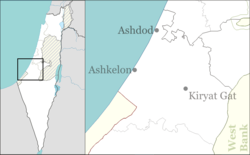Beit Nir (Hebrew: בֵּית נִיר, lit. House of tilled soil) is a kibbutz in the Lakhish region of south-central Israel. Beit Nir falls under the jurisdiction of Yoav Regional Council and is a member of the Kibbutz Movement. In 2022 its population was 616.[1]
Beit Nir
בֵּית נִיר بيت نير | |
|---|---|
 | |
| Coordinates: 31°38′52″N 34°52′26″E / 31.64778°N 34.87389°E | |
| Country | |
| District | Southern |
| Council | Yoav |
| Affiliation | Kibbutz Movement |
| Founded | 1955–1957 |
| Founded by | Hashomer Hatzair |
| Population (2022)[1] | 616 |
| Website | www |
History
editBeit Nir was established in August 1957 by members of Hashomer Hatzair on land that belonged to the depopulated Palestinian village of Kudna.[2] It was named for Max Bodenheimer, a prominent German Zionist (Boden means "ground" in German and Heim means "home").
Economy
editThe kibbutz economy is based on agriculture, a soft drinks factory, and a jewelry workshop that sells its wares in Europe and the United States. The kibbutz merged with Gat to form the corporate entity "Ganir", which manufactures fruit juice for export and sale in Israel. In Israel the juice is sold under the brand name Primor (פרימור).[3]
The kibbutz grows wheat, watermelons and cotton, and produces olive oil. Beit Nir also operates a cattle ranch.
Moshe Shek Museum
editThe museum displays ceramic works and bronze sculptures by Moshe Shek (1935-2011). Shek, who was born in Poland, became a founding member of the kibbutz and a member of the Hashomer Hatzair organisation, and studied at the New Bezalel art school. His wife Shula offers guided tours of the museum.[4]
Gallery
edit-
Sign post at entrance to Kibbutz Beit Nir
-
Kibbutz Beit Nir
-
Kibbutz Beit Nir
-
Greenery in Beit Nir
-
Water tower in Kibbutz Beit Nir
References
edit- ^ a b "Regional Statistics". Israel Central Bureau of Statistics. Retrieved 21 March 2024.
- ^ Khalidi, Walid (1992), All That Remains, Washington D.C.: Institute for Palestine Studies, p. 218, ISBN 0-88728-224-5
- ^ Is Israel ready for vegetable juice Haaretz, 3 September 2008
- ^ Website of the Moshe Shek Museum, accessed 25 Jan 2022.
External links
edit- Official website (in Hebrew)
- Photos of Beit Nir

